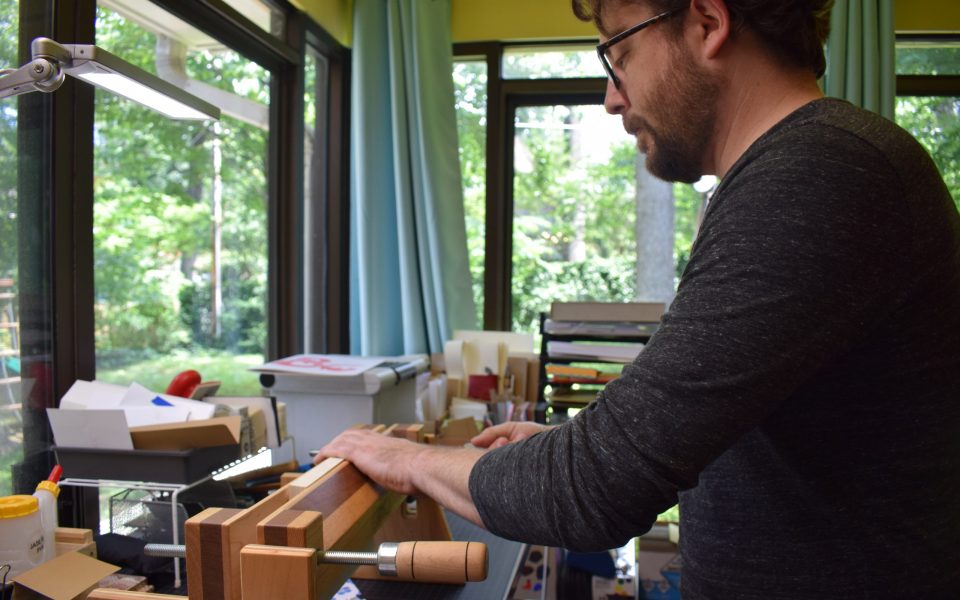Gerald Ward doesn’t dabble. Not in board games, RPGs or craft beer — especially not book arts. In all his endeavors, he goes all in.
Ward earned both his bachelors and masters at UNCG, in English and library science, respectively, but while working at Pages Past, a used and rare bookshop in Greensboro, he happened upon a bookbinding manual by Bernard Middleton: The Restoration of Leather Binding, a treatise on English bookbinding and restoration.

©
He began to teach himself, re-toning ripped pages with tea in his spare time until he learned professional methods at Etherington Conservation Services. There, he worked with second folios of Shakespeare, a 13th Century Egyptian codex, first-edition Dickens’ serials bound for publication and an Eliot Indian Bible, the first bible printed in British North America, written in the lost Algonquin language.
Now he’s the senior conservator at Kofile Technologies’ Greensboro office where the oldest documents that grace his fingertips stem from the Revolutionary War era. The largest paper conservation company in the United States deals primarily with county and municipal documents, everything from property deeds to slave records throughout the Southeast, in Ward’s case. There’s a reason most documents he sees are from the last century-and-a-half.
“Up until early to mid 19th Century they would use cotton in the paper and… with the high cotton content, it was pretty pH neutral,” Ward says. “Then they realized they could make paper out of wood pulp. It’s not the best. It decays, and the acidity rises, and it becomes brittle, and that’s why you can look at a book from the 19th Century or early 20th Century and it’ll be beige or brown and you can bend the corner and it’ll snap off, then look at a book from the 17th Century and it won’t. It may have environmental issues with it from smoke to insects or mold but there’s no inherent acidity to the paper.”
So, he spends his days mending, deacidifying, ironing mylar sleeves and digitizing records, but when he goes home, he’s the bibliopathologist, a self-dubbed moniker that is also the name of his side project teaching bookbinding.

©
“What I really enjoy doing is teaching workshops,” Ward says. “I think it’s a good outlet for me but also for people who have different backgrounds, some in art or others who work a 9-to-5 office job and just want to do something. That’s awesome. You don’t have to be ‘artistic’ to do this — it’s very structural — but you have to be able to undo what you’ve done, both in bookbinding and in conservation.”
The quiet, meticulous procedures take place at a desk overlooking his daughters’ playset in an add-on where he also homebrews beer — quite the contrast to the 14,000 square-foot conservation lab where he spends his working hours.
It starts with a knot.
Ward eases a waxed, royal-blue thread through a blunt needle’s wide open eyelet. He reaches for thinner thread when sewing up a text block — the technical term for everything between the outer covers — but a waxy coating ensures the thread won’t kink up on itself and holds its position. Once the needle travels through the hole, Ward reaches for pliers. It requires more strength than you might assume to pull the thread through. These holes are small and when the paper material surrounding them flares up, he smooths it out with a Teflon folder. It’s an elegant practice, however practical, straddling the line between art and science.

“There’s a level of catharsis to this,” Ward says. “I am pushing form onto a formless world. I’m bending material to my will.”
He’s partial to creating new sewing structures for text-block leather bindings, all by hand, with the aid of a finishing press a friend made. Depending on the project, he’ll measure down to 32nd of an inch.

©
“I think a lot of these older art forms like papermaking and paper marbling never really died and maybe it’s just that now many millennials are interested in older stuff, stuff that’s not mass produced,” Ward says.
He has a point about millennials’ aversion to planned obsolescence, and penchant for bespoke goods.[pullquote]Learn more and register for bookbinding workshops at bibliopathologist.com.[/pullquote]
“If you make somebody a book, how much of a sociopath would they have to be to not appreciate it? There’s a whole level of intention to it because you’ve folded the paper, you’ve made the hole, you’ve sewn the text block, you’ve made the cover. Whatever your binding style is it’s all intentional, it’s all effort, it’s all work.”
Behind chairs laden with inherited family quilts, visitors find that no less than a quarter of his many, many books focus on the histories and science of bookbinding, papermaking, chemistry of ink and of books themselves.

©
He pulls out a self-bound compilation of articles about inks from Gutenberg bibles.
“I’m not proud of it,” he says with a smirk. “I went through a Gutenberg phase, like people do.”
He is a little proud of it.
He grabs his Gutenberg press pencil sharpener to demonstrate, describing how the impressions of the lead type into the 15th Century cotton paper are still visceral. It is easy to imagine him holding one of the 42-line pages like someone might look at a lover or a holy text. It seems the magic, for Ward, is in the knowing, and in the sacred details.
Join the First Amendment Society, a membership that goes directly to funding TCB‘s newsroom.
We believe that reporting can save the world.
The TCB First Amendment Society recognizes the vital role of a free, unfettered press with a bundling of local experiences designed to build community, and unique engagements with our newsroom that will help you understand, and shape, local journalism’s critical role in uplifting the people in our cities.
All revenue goes directly into the newsroom as reporters’ salaries and freelance commissions.





Leave a Reply